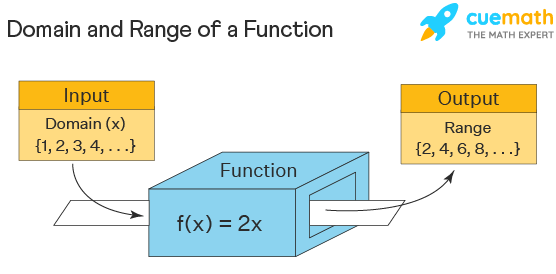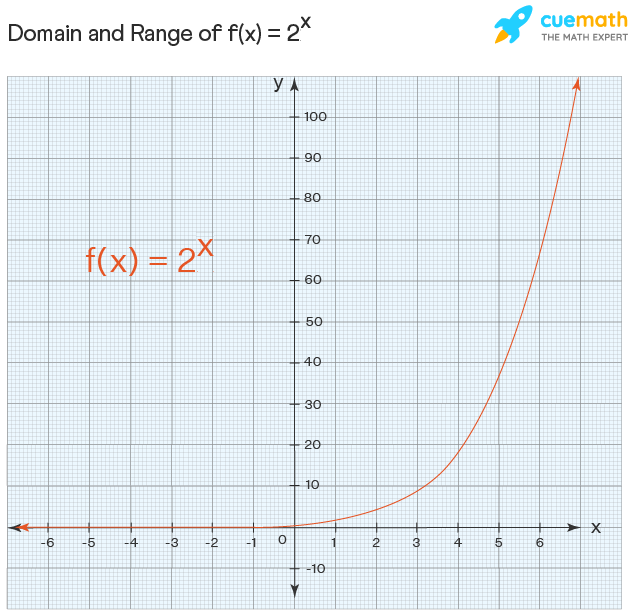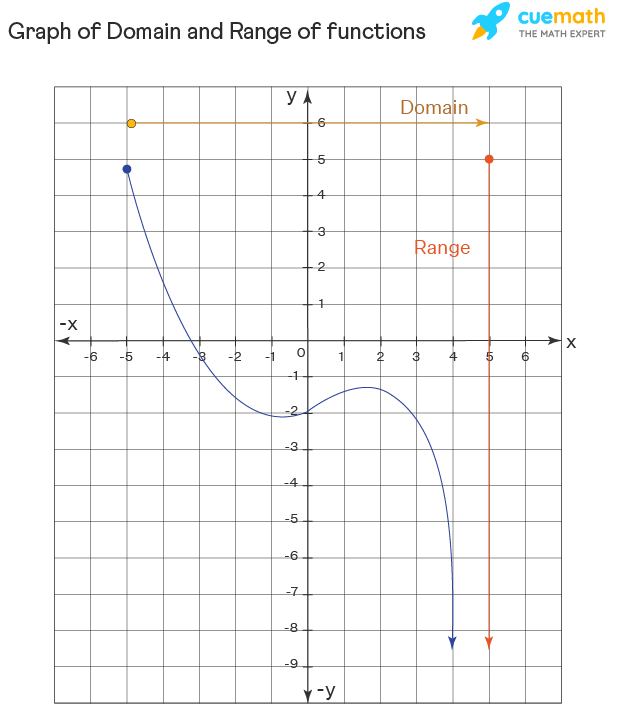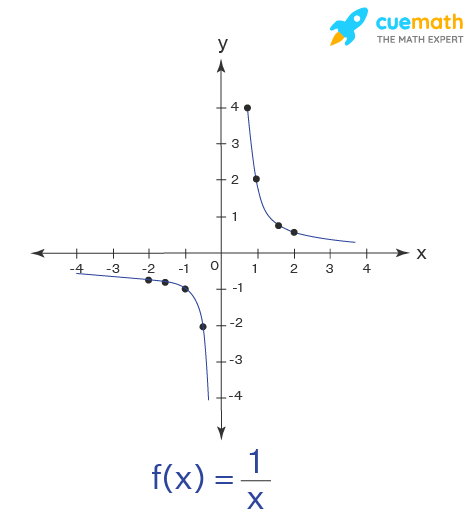How To Find Domain In Interval Notation
Domain and Range
Functions in mathematics can exist compared to the operations of a vending (soda) machine. When you put in a sure corporeality of money, you can select unlike types of sodas. Similarly, for functions, we input dissimilar numbers and we get new numbers as the result. Domain and range are the main aspects of functions. You can use quarters and ane-dollar bills to purchase a soda. The machine will not give yous any flavor of the soda if pennies are input. Hence, the domain represents the inputs we can have here, that is, quarters and 1-dollar bills. No matter what amount you pay, you won't get a cheeseburger from a soda machine. Thus, the range is the possible outputs nosotros tin can have here, that is, the flavors of soda in the motorcar. Let us larn to observe the domain and range of a given function, and also graph them.
| i. | What is Domain and Range? |
| ii. | Domain and Range of a Office |
| 3. | Domain of a Function |
| 4. | Range of a Part |
| 5. | How To Detect Domain And Range? |
| 6. | Domain and Range of Exponential Functions |
| seven. | Domain and Range of Trigonometric Functions |
| 8. | Domain and Range of an Absolute Value Function |
| 9. | Graphs of Domain and Range |
| 10. | FAQs on Domain and Range |
What is Domain and Range?
The domain and range are defined for a relation and they are the sets of all the x-coordinates and all the y-coordinates of ordered pairs respectively. For example, if the relation is, R = {(1, 2), (2, ii), (3, 3), (4, three)}, then:
- Domain = the set of all 10-coordinates = {1, 2, 3, 4}
- Range = the ready of all y-coordinates = {2, 3}
Nosotros tin can visualize this here:

Domain and Range of a Function
The domain and range of a function are the components of a function. The domain is the set of all the input values of a function and range is the possible output given by the function. Domain→ Function →Range. If there exists a function f: A →B such that every element of A is mapped to elements in B, so A is the domain and B is the co-domain. The image of an element 'a' under a relation R is given by 'b', where (a,b) ∈ R. The range of the function is the set of images. The domain and range of a role is denoted in full general as follows: Domain(f) = {x ∈ R} and range(f)={f(x) : x ∈ domain(f)}

The domain and range of this function f(10) = 2x is given as domain D ={10 ∈ Northward } , range R = {(y): y = 2x}
Domain of a Office
A domain of a part refers to "all the values" that go into a function. The domain of a part is the gear up of all possible inputs for the function. Consider this box every bit a part f(ten) = 2x . Inputting the values 10 = {one,2,3,four,...}, the domain is simply the set of natural numbers and the output values are called the range. Simply in general, f(ten) = 2x is defined for all real values of ten and hence its domain is the set of all real numbers which is denoted by (-∞, ∞). Here are the full general formulas used to find the domain of different types of functions. Here, R is the set of all existent numbers.
- Domain of any polynomial (linear, quadratic, cubic, etc) function is R.
- Domain of a square root function √x is ten≥0.
- Domain of an exponential office is R.
- Domain of logarithmic function is x>0.
- To find the domain of a rational role y = f(10), set the denominator ≠ 0.
Range of a Function
The range of a role is the set of all its outputs. Case: Allow u.s.a. consider the role f: A→ B, where f(x) = 2x and each of A and B = {set of natural numbers}. Here nosotros say A is the domain and B is the co-domain. So the output of this function becomes the range. The range = {set of fifty-fifty natural numbers}. The elements of the domain are called pre-images and the elements of the co-domain which are mapped are called the images. Here, the range of the office f is the set of all images of the elements of the domain (or) the gear up of all the outputs of the function. In the upcoming sections, nosotros can see how to find the range of different types of functions. Here are the general formulas used to discover the range of different types of functions. Note that R is the ready of all real numbers here.
- Range of a linear function is R.
- Range of a quadratic function y = a(10-h)two + k is:
y≥k, if a>0 and
y≤g, if a<0 - Range of a square root function is y≥0.
- Range of an exponential part is y>0.
- Range of logarithmic function is R.
- To find the range of a rational part y = f(ten), solve information technology for x and set the denominator ≠ 0.
How To Find Domain And Range?
Suppose Ten = {1, 2, iii, 4, v}, f: X → Y, where R = {(10,y) : y = x+i}.
Domain = the input values. Thus Domain = X = {i, 2, three, 4, 5}
Range = the output values of the role = {2, 3, four, 5, 6}
and the co-domain = Y = {2, 3, 4, 5, half-dozen}
Let'south understand the domain and range of some special functions taking different types of functions into consideration.
Domain and Range of Exponential Functions
The function y = ax, a ≥ 0 is divers for all real numbers. Hence, the domain of the exponential function is the unabridged existent line. The exponential function always results in a positive value. Thus, the range of the exponential role is of the form y= |ax+b| is y ∈ R , {y > 0}. Domain = R, Range = (0, ∞)
Example: Look at the graph of this role f: twox

Discover that the value of the function is closer to 0 as ten tends to ∞ but it volition never attain the value 0. The domain and range of an exponential functions are given as follows:
- Domain: The domain of the role is the set R.
- Range: The exponential function always results in positive existent values.
Domain and Range of Trigonometric Functions
Look at the graph of the sine role and cosine office. Observe that the value of the functions oscillates betwixt -1 and 1 and information technology is defined for all existent numbers.

Thus, for each of the sine and cosine functions:
- Domain: The domain of the functions is the set R.
- Range: The range of the functions is [-ane, i]
The domain and range of all trigonometric functions are shown below:
| Trigonometric Functions | Domain | Range |
|---|---|---|
| Sinθ | (-∞, + ∞) | [-1, +1] |
| Cosθ | (-∞ +∞) | [-one, +ane] |
| Tanθ | R - (2n + 1)π/2 | (-∞, +∞) |
| Cotθ | R - nπ | (-∞, +∞) |
| Secθ | R - (2n + one)π/2 | (-∞, -one] U [+i, +∞) |
| Cosecθ | R - nπ | (-∞, -one] U [+one, +∞) |
Domain and Range of an Accented Value Role
The office y=|ax+b| is defined for all real numbers. And then, the domain of the absolute value function is the gear up of all real numbers. The absolute value of a number always results in a non-negative value. Thus, the range of an absolute value function of the form y= |ax+b| is y ∈ R | y ≥ 0. The domain and range of an absolute value office are given every bit follows
- Domain = R
- Range = [0, ∞)
Case: |six-x|
- Domain: The domain of the function is the set up R.
- Range: We already know that the absolute value office results in a non-negative value always. i.e., |vi-x| ≥ 0, for all x.
Domain and Range of a Square Root Role
The part y= √(ax+b) is defined only for x ≥ -b/a
Then, the domain of the square root function is the gear up of all real numbers greater than or equal to b/a. We know that the square root of something ever results in a non-negative value. Thus, the range of a foursquare root function is the gear up of all non-negative real numbers. The domain and range of a square root function are given equally: Domain = [-b/a,∞), Range = [0,∞)
Case: y= ii- √(-3x+2)
Domain: A square root function is defined only when the value inside information technology is a non-negative number. Then for a domain,
-3x+two ≥ 0
-3x ≥ -2
x ≤ 2/3
Range: Nosotros already know that the square root part results in a non-negative value e'er.
√(-3x+2)≥ 0
Multiply -1 on both sides
-√(-3x+two) ≤ 0
Adding 2 on both sides
2-√(-3x+2)≤ 2
y≤ 2
Graphs of Domain and Range
Another mode to identify the domain and range of functions is by using graphs. The domain refers to the set up of possible input values. The domain of a graph consists of all the input values shown on the x-centrality. The range is the gear up of possible output values shown on the y-axis. The easiest method to discover the range of function is by graphing information technology and looking for the y-values covered by the graph. To find the range of a quadratic part, it is sufficient to see if it has a maximum or minimum value. The maximum/minimum value of a quadratic role is the y-coordinate of its vertex. To find the domain of the rational function, set the denominator every bit 0 and solve for the variable. The domain is denoted by all the values from left to right along the x-axis and the range is given by the span of the graph from the superlative to the lesser.

Important Notes on Domain and Range:
- The domain and range of role is the set of all possible inputs and outputs of a function respectively.
- The domain and range of a part y = f(ten) is given as domain= {x ,ten∈R }, range= {f(x), x∈Domain}.
- The domain and range of any office can exist found algebraically or graphically.
☛ Too Check:
- Graphing Functions
- Cubic Functions
- Inverse Trigonometric Functions
Examples on Domain and Range
go to slidego to slidego to slide

Peachy learning in high school using simple cues
Indulging in rote learning, you are likely to forget concepts. With Cuemath, you lot will larn visually and exist surprised by the outcomes.
Book a Free Trial Class
Exercise Questions on Domain and Range
go to slidego to slide
FAQs on Domain and Range
What is the Domain and Range of a Role?
The domain and range of a part are the set of all the inputs and outputs a part can requite respectively. The domain and range are of import aspects of a function. The domain takes all the possible input values from the prepare of real numbers and the range takes all the output values of the office.
How Do Y'all Write the Domain and Range?
Nosotros write the domain and range of a function as the prepare of all the inputs a function tin can take and the outputs of the functions respectively. The domain and range are written from the smaller values to the larger values. The domain is written from left to correct and the range is written from the top of the graph to the lesser.
What is The Natural Domain and Range of a Role?
The natural domain and range of a office are all the possible input values and the output values of the function respectively. Domain(f) = {x∈R} and range(f)={f(x):x ∈ domain(f)}.
What is The Domain and Range of a Constant Office?
Let the abiding part exist f(x)=thousand. The domain of a abiding part is given past R, that is, the set of real numbers. The range of a constant office is given past the singleton set, {k}. The domain and range of a constant function is given equally domain = x∈R and range = {k}, which is a singleton set.
How to Find the Domain of a Office which is Rational?
To detect the domain of a rational role, we just gear up the denominator not equal to zero. For instance, to discover the domain of f(10) = two/(x-iii), we gear up x-three ≠ 0, by solving this, we get x≠iii. And so the domain is the set of all rational numbers except 3. This can be written in the interval notation as (-∞, 3) U (three, ∞).
How to Find the Range of a Rational Part?
To observe the range of a rational function, we just solve the equation for x and apply set up the denominator not equal to nada. For example, to find the range of y=two/(x-iii), solve information technology for ten showtime. Then we get, x-3 = 2/y and from this, x = (two/y) + iii. And then its range is y≠0 (or) in interval notation, (-∞, 0) U (0, ∞).
What are the Rules to Find the Domain of a Role?
Here are some general rules used to find domain of dissimilar types of functions:
- f(x) = polynomial, the domain is the set of all real numbers.
- f(x) = 1/10, domain if the set of all existent numbers but x≠0.
- f(x) = √x, domain if the set of all real numbers such that 10 ≥ 0.
- f(x) = ln x, domain is the set up of all real numbers such that x > 0.
How to Find The Domain and Range of Function Algebraically?
Let the office exist y=f(x). Permit the states find the domain and range of this function algebraically.
To calculate the domain of the function, we merely solve the equation to determine the values of the independent variable x. To calculate the range of the function, we simply express x every bit ten = k(y) and then find the domain of g(y).
How to Find The Domain and Range of an Equation?
To find the domain and range, we simply solve the equation y = f(10) to make up one's mind the values of the independent variable x and obtain the domain. To calculate the range of the part, we merely express ten equally 10=thou(y) and then find the domain of g(y).
What Is The Difference Between Domain and Range of a Function?
Domain and Range of a function are the components of a office. The domain of a function is the set up of all possible inputs for the part, whereas the range of function is the set of all the outputs a function can give.
What is The Domain and Range of a Relation?
the domain and range of a relation is found equally follows. Let R be the relation from a non-empty set A to a not-empty set B. The domain and range of the relation are the set of start elements and the second elements respectively in the ordered pairs in relation R is called the domain.
What is the Domain and Range of Blended Functions?
Let the composite function be \(h=f \circ g\). The domain and range of h are determined equally follows. The domain of h is either same as f or lies inside the domain of f. The range h must prevarication within the range of 1000. Let f(ten) = ten2 and 1000(x) = x+ three. Nosotros know that f: X →Y and g: Y →Z. And then fog: X →Z. f(g(10)) = (x+three)2. Thus the domain and range are: domain= {All the elements in set Ten}, range= {all the elements in set Z}
What is the Domain and Range of a Quadratic Part?
The domain and range of a quadratic office y=a(ten-h)2+k determine the nature of the parabola: whether it is upward or downwardly or facing to the left or to the right.
- y ≥ k, if the function has a minimum value, that is, when a>0(parabola opens upwardly)
- y ≤ 1000, if the part has a maximum value, that is, when a<0(parabola opens down)
Source: https://www.cuemath.com/calculus/domain-and-range-of-a-function/
Posted by: fraileyallose38.blogspot.com



0 Response to "How To Find Domain In Interval Notation"
Post a Comment